The making of WIND
Published on March 28th, 2007
Dennis Conner’s comeback win at the 1987 America’s Cup in Australia inspired a Japanese movie producer to make a feature film about sailboat racing – WIND. Quite a few of the usual suspects of the sailing scene got involved, among them being Sail Magazine’s West Coast Editor Kimball Livingston, who took time out to provide some stories from this groundbreaking project…
Late in the production of the 1992 movie, WIND, Peter Gilmour was steering a 12-Meter in the Indian Ocean off Fremantle in just what the camera wanted, lots of breeze and whitecaps. Mind you, this wasn’t natural territory for a heavy old Cup campaigner that was being asked to fly a masthead spinnaker where no such thing had flown before.
But this 12-Meter was flying . . . The Whomper.
First assistant director Dean Jones hovered overhead in a helicopter with the cameras rolling. He was saying something like, “Looks good, guys, looks good.”
(Break)
Here’s background for anyone who came in late: Carroll Ballard was the director, and Francis Ford Coppola the executive producer, of the one feature film that gave yacht racing feature treatment. Director of Photography John Toll went from WIND to “Legends of the Fall” and won an Oscar for that, then to “Braveheart” and won an Oscar for that, which should complete the case that the talents were extraordinary. But WIND never took off at the box office. Some people liked it, some didn’t, and lots of serious sailors walked out grousing that, yeah, maybe the sailing sequences got you going, but the story did not achieve the smell of authentic camel dung in high heat in the desert. Or, you know, something.
Carroll was firm that the Good Guys had to come from behind in the Big Moment to win the Big Race (no argument), and he was firm that the critical scene had to turn on something visual that anybody in the audience could see and understand. So why not a supersized masthead spinnaker on a fractional rig? Why not a sail sewed up special by tactician Kate (played by Jennifer Grey) and pulled out of the bag in desperation on a rootin’ tootin’ screaming reach?
Thus “Gilly” on the helm, watching the waves while he steers but doing an awful lot of looking up, and not at the helicopter where Jones is excitedly saying some equivalent of:
“Looking good good good.”
Instead, Gilly’s even more excited and his voice is up and he’s yelling:
“It’s coming down it’s coming down!”
“No, it looks good.”
The speedo touched 19 knots —
“It’s coming down.”
“Keep it up.”
“Not the sail. The mast. The F!#@ING MAST IS COMING DOWN!”
A beat. (As they say in scriptwriting.) And, well, it didn’t come down — the mast — but it’s lucky that Jones got enough footage to make the scene work. The backstay broke and went flying, and only quick work on the part of the crew kept a stick in the boat. I was not on the set, so any number of people might fine-tune this account, but I think I got the gist of it. I’ve been hearing the stories long enough, having entered as a technical consultant at an early meeting of producers Tom Luddy/Mata Yamamoto, director Ballard, and writer number two in a long chain of writers. That guy’s final, submitted script opened with a babe in a leopardskin bikini driving a cigarette boat on Narragansett Bay. No way was that script going to fly, but, ironically, now that the Cup is in the Med, maybe it could.
So here we are, 15 years downstream from the movie’s release, and the Curmudgeon is asking me to write a guest editorial on the subject. I could say, “The statute of limitations has run out,” but no, it’s an intriguing prospect. I remember WIND.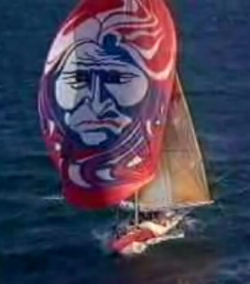
It begins: I had met Zoetrope Studios producer Tom Luddy (if you know movies, you know he’s a hero) at a Cannes Film Festival, and I reckon that when Tom got a contract a few years later to do a sailing flick, I was the only sailor he knew.
By the time WIND was released, Tom Luddy knew lots of sailors, and I had gone from consultant to writer to consultant-to-editor to writer again, and it wasn’t always comfortable. I recall tiptoeing into one early-morning script meeting, looking around, and asking, “Is anything all right?”
But these were Coppola’s people: smart professionals working very hard on things that never come easily, and I only got fired twice.
Excepting an auteur production, a movie is a strange beast, a total collaboration. Seeing the movie now is like meeting a grownup child raised by someone else. I can pat myself on the back for insisting from the get-go that the movie had to have small boats in it, and sure, we could have a woman in a pivotal sailing role. So it’s ironic that there are no women in pivotal roles onboard in Valencia (Jennifer Grey, Shosholoza needs you). I had nothing to do with The Whomper and hated it, but later, when Paul Cayard and his EF Language guys racing around the world started calling one of their sails The Whomper, and as The Whomper became the one wrinkle from the movie that sort of gained a life of its own, I found myself thinking, doggies, I wish that was mine. It would be such a twisted form of immortality . . .
Taking the temperature: Vincent Canby of the NY Times liked it, and International 14 sailors usually dig the movie because I-14s are players onscreen. The scale runs all the way to one guy I’ve crewed for a little bit, a big boat sailor from Southern California named Roy Disney, who called WIND, “Quite possibly the worst movie ever made.”
Or not, but it’s also not the movie any of us set out to make, and the enterprise was so huge that what I’m doing in writing this is truly a case of the blind man sampling a tiny piece of the elephant. Not only was Gilmour there as sailing master but other top sailors were there to sail the boats as actors.
Everybody has a story.
There was ample sailing and screen time for the likes of Bruce Epke (the Sheik onscreen and off), Stu Silvestri, and John Sangmeister, for example. Qualifications? Well, Sangmeister crewed for Dennis Conner in the 1987 and 1992 Cups and now is an owner of Gladstone’s, a waterfront restaurant and sailors’ haunt in Long Beach, California. Epke and Silvestri were, among so many other things, some of Jack Sutphen’s famous mushrooms. It’s a good bet that Matthew Modine and Jennifer Grey have never forgotten that they really did sail an I-14 together in enough breeze to go medium-fast, briefly. Lisa Blackaller (Tom’s daughter) worked as assistant to the director and stood in for Jennifer as needed and was at least as cute.
I had the good fortune to be paired off writing with Roger Vaughan, whose book, “The Grand Gesture” is only one of his many, but it’s my choice as the book about the culture of racing 12 Meters at Newport. Roger didn’t set out to teach history; rather to take you to places other sailing books don’t. I don’t remember who I’m ripping off here, but one of the reviewers said something like, “It is a good book because the author is not part of the yachting establishment, and does not wish to be.”
Lots of us, including Roger Vaughan, are hoping for a nailbiting series in Valencia, 2007, which is what brings this to mind. The Newport world was something very different. If you have a historical/sociological bent and you’re looking for a bit of contrast, or if you’re thinking of Newport as the good old days, you can find used copies of “The Grand Gesture” with only a bit of online searching.
Speaking of searching, let’s start looking for a bottom line here.
It’s a piece of work concocting a drama about the America’s Cup. You got your challenger eliminations structure, you got your history-as-baggage, but you don’t got your evil bad guy. Surely we’ve all seen at least one old racecar movie with a bad guy sabotaging the brakes on the good guy’s car, but you don’t want to go there.
If and when the ultimate sailing movie gets made, it will grow from a smaller seed (I’ll be one of the early ticket purchasers for “Morning Light”). WIND was driven by financing from Japan, which was planning an America’s Cup challenge (co-producer Mata Yamamoto had co-produced “Mishima” with Tom Luddy, and Mata made this movie happen). Mata’s first move was to buy the screen rights to Dennis Conner’s post-Australia book, “Comeback.” The very first script included a scene of Dennis having breakfast . . .
As I think I mentioned, many scripts were produced.
For a lot of the crew, the best times happened in the desert, shooting the scenes where the boat was supposedly under construction and they didn’t have to work a couple of 12-Meters in wind and waves. For me, the best times were early-on, when I was a consultant, and we’d go to dinner at Chez Panisse and I’d talk and people would take notes. Then they fired writer number two, and slotted me in behind him, which changed everything. My next meeting had more of an edge.
The surreal aspect came much later, in post-production on Sound Stage 29 (there is no Sound Stage 1 through 28) up a canyon behind Coppola’s house in the Napa Valley. I had been off the picture for a while, but here I was, called back in, and I was sitting on one side of a plywood wall, allegedly typing out scenes on a laptop, while Matthew and Jennifer on the other side of the wall were acting out reshoots of the “will you go with me or not” scene in a mockup of the cottage back in Newport.
Where WIND succeeds, no argument, is in the editing. That’s true also of my favorite Carroll Ballard movie, “Never Cry Wolf.” And Carroll’s hit, “The Black Stallion,” is a brilliant example of a small story that allowed the filmmaker to discover the moon and stars glowing in a grain of sand. Having raised a horse-crazy daughter, I’ve seen “The Black Stallion” more often than any other movie, ever, and I’ve never tired of its lyric quality. That’s not the way I would describe WIND, and neither would Carroll. While the crew was shooting in Newport, he told interviewer David Morgan:
“You can only make a film like that [the section of “The Black Stallion” shot on the island where horse and boy are marooned] when you spend a lot of time with a small crew. This picture has taken a lot of time but it’s mainly devoted to the mechanics of sailing and of getting the boats and the guys out on the water and getting the wind blowing enough to make it interesting, and then the thing with all the characters, a story that takes place on two different continents and all of that, the production is so huge that you know we’re not going to have time to do that kind of thing.
“It’s logistics and psychological dynamics and insurance, agents’ fees, aaaaallllllll stuff you have to deal with that explodes into the horror of the thing. In a way, the Matthew Modine character comes out naively, sort of the way I came onto films, that all you need is a camera and you get some guys, use the real small crew and you make personal stories. That’s how I came out of film school, thinking it would be possible, but it isn’t possible; it’s totally impossible. Essentially you’ve got to start with a successful con game to raise the money, and to get somebody sold on the project you’ve got to put together a package, and in order to do that you have to deal with a hundred different people who have their own interests – agents and the lawyers and the studio people, preparation people, dah de dah. And you’ve got to deal with the Teamsters and the fact that the lunch isn’t served on time and a billion other things that you can’t possibly imagine. Making a movie oftentimes takes a back seat to just moving the army from here to there.”
Ballard and Toll, shooting on deck with handheld, soundsynched cameras then newly-developed, captured the sailing footage for WIND. There’s no CG; only the collision (a few seconds) is fake. And it was more than slightly handy to have the double wheels, so that Gilmour could steer off-camera while the actors did their thing opposite. Carroll was not/is not a racer, but he still sails the William Garden ketch that has been his baby for decades.
In the end, the people who had been in the movie business went on to the next movie, and the rest of us went back to doing what we do. But it was impossible in the moment not to enjoy the money and the company and the way that people treat you as if you’re important because you have a movie contract. I can’t tell you how to pull this off, but I can tell you that if you ever manage to take your wife to dinner at Trader Vic’s with a movie star who’s angling for a spot in your film, on a night when half a dozen of her girl friends are in the room, you’ve got at least a six month window in which you can do no wrong.



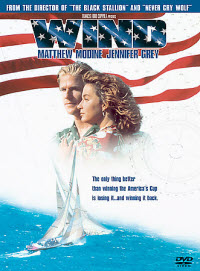
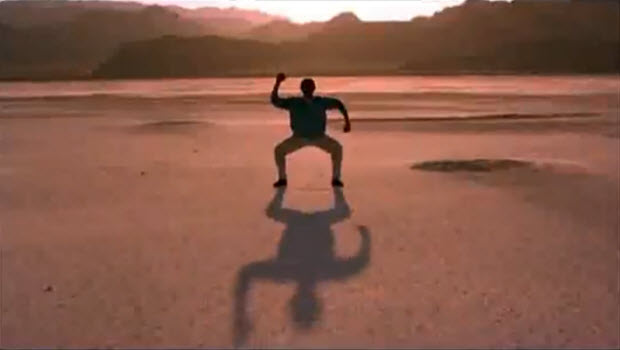

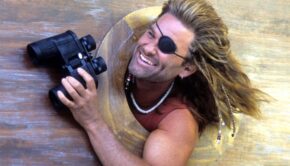
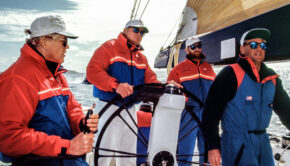

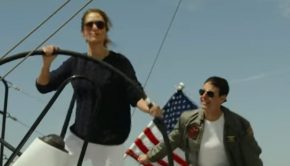
 We’ll keep your information safe.
We’ll keep your information safe.